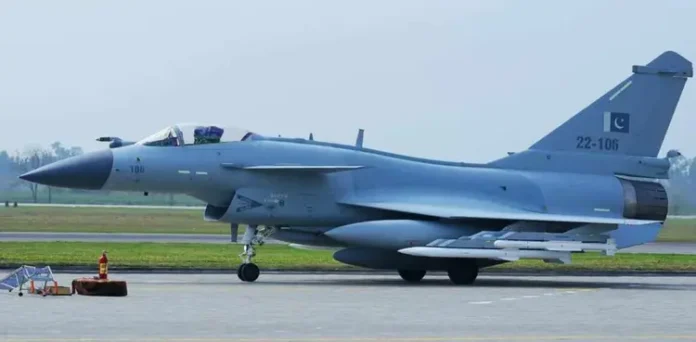Tensions between Pakistan and India escalated dramatically this week as the Pakistani military announced the successful downing of 25 Indian-origin drones that violated its airspace. These drones, identified as Harop loitering munitions, were neutralized using a combination of soft-kill and hard-kill techniques, according to the Inter-Services Public Relations (ISPR).
25 Indian Harop Drones Taken Down
In a press briefing held on Thursday, Director General ISPR Lt. Gen. Ahmed Sharif Chaudhry confirmed that Pakistan’s armed forces intercepted and destroyed 25 Harop drones deployed by India across the Line of Control (LoC) and other key border points. The drones were shot down in multiple areas, including major cities like Karachi and Lahore, highlighting the seriousness of the breach.
“The use of Harop drones is a clear provocation. It is naked aggression, and our forces are responding with full alertness,” said Gen. Chaudhry. He also displayed debris of the destroyed Harop dronesas visual evidence of the incursion.
What Is the Harop Drone?
The Harop drone, also referred to as a loitering munition or “suicide drone,” is an advanced autonomous weapon system developed by Israel Aerospace Industries (IAI). Unlike conventional drones, loitering munitions are designed to hover over the battlefield and attack targets by crashing into them with a built-in warhead.
Key Features of the Harop Drone:
-
Autonomous and Manual Modes: Can operate independently or under human control.
-
Loitering Capability: Can hover over a target area for hours, searching for enemy signals.
-
Precision Targeting: Primarily used to destroy radar systems, air defenses, and high-value enemy targets.
-
Flexible Launch Options: Can be launched from land-based vehicles, ships, or aircraft.
According to IAI, these drones are particularly effective in modern warfare due to their stealthy nature and high precision.
Expert Insights on Drone Warfare
Speaking to Dawn.com, Dr. Fahad Irfan Siddiqui, associate professor at Mehran University of Engineering and Technology, said that Harop drones represent cutting-edge military technology. They are used for payload attacks, surveillance, and electronic warfare.
Dr. Siddiqui explained that, unlike consumer drones which use Ultra High Frequency (UHF) and can be jammed using standard equipment, military-grade drones are usually satellite-operated and far more difficult to neutralize.
“Military drones like the Harop drones can’t be easily jammed. Their frequencies are encrypted and satellite-linked. Disabling them requires advanced counter-drone systems or satellite-level blocking,” he said.
He also mentioned that international law mandates registration for any drone above 250 grams, and drones cannot fly within a 5-kilometre radius of military bases or international borders.
Violation of International Humanitarian Law
The use of loitering munitions on civilian areas, as alleged by Pakistan, constitutes a serious breach of International Humanitarian Law (IHL). Such actions can be classified under Lethal Autonomous Weapon Systems (LAWS), raising ethical and legal questions about their deployment without human intervention.
Under IHL, targeting civilian infrastructure or areas is considered a grave violation. The UN and international watchdogs continue to debate the legality and regulation of autonomous weapon systems like Harop drones.
India’s Military Partnership with Israel
India has significantly ramped up its defense purchases from Israel over the past decade. According to TRT Global, India imported $2.9 billion worth of defense equipment from Israel, which includes:
-
Harop and other combat drones
-
Advanced missile systems
-
Radar and surveillance technology
This military partnership has made India one of the top importers of Israeli defense systems. The Harop drone, in particular, is a centerpiece in this collaboration.
Global Usage of Harop Drone in Conflicts
Azerbaijan-Armenia Conflict
The Harop drone was first widely recognized during the Nagorno-Karabakh war between Azerbaijan and Armenia. Azerbaijan used it effectively to destroy Armenian air defenses and military vehicles, including a reported strike on a bus carrying troops in 2016.
Syrian War
In 2018 and 2024, the Harop drones was reportedly used against the Syrian Armed Forces, where it destroyed a Russian-made SA-22 Greyhound air defense system.
Other Alleged Users
Reports suggest countries like Turkey may have used the Harop drone as early as 2005, though this remains unconfirmed.
Pakistan’s Response Strategy
Pakistan has developed both technical (soft-kill) and weaponized (hard-kill) capabilities to neutralize threats from aerial incursions. These include:
-
Electronic Warfare Units: For jamming or misdirecting drones.
-
Anti-Drone Weapons: Surface-to-air missiles and automated anti-air systems.
-
Surveillance Systems: Radar and early-warning systems to detect hostile UAVs.
Lt. Gen. Chaudhry emphasized that Pakistan remains vigilant and is “neutralizing threats as they emerge,” indicating a state of high alert along the borders.
Implications for Regional Security
The escalation in drone warfare between India and Pakistan could destabilize regional peace. The increasing reliance on autonomous and semi-autonomous drones by both nations points to a new era of high-tech warfare.
Experts believe that without clear international regulation on drone usage, especially loitering munitions, such confrontations could lead to miscalculations and unintended conflict escalation.
Conclusion
The downing of 25 Indian Harop drones by Pakistan marks a dangerous spike in cross-border tensions. With the use of advanced loitering munitions and autonomous drones, both countries are entering an age of sophisticated, high-risk warfare. There is an urgent need for international diplomatic engagement and stricter regulations to prevent further escalation and uphold the principles of international law.




